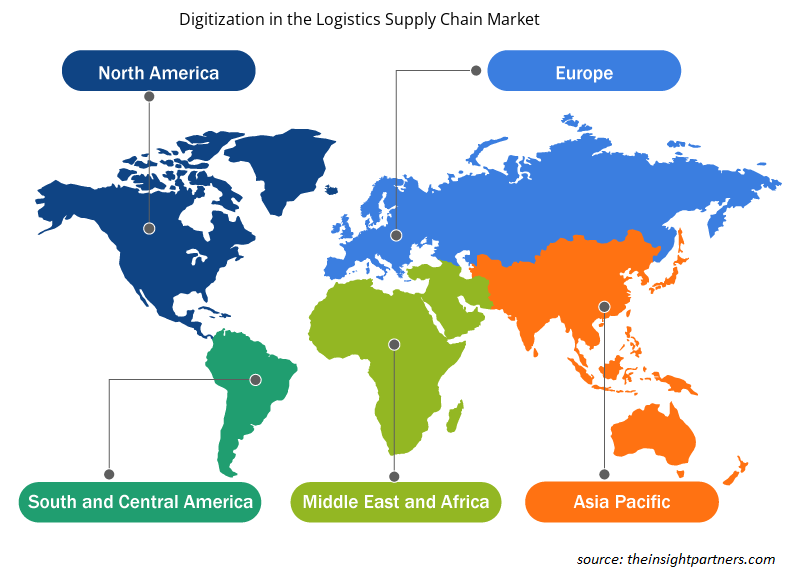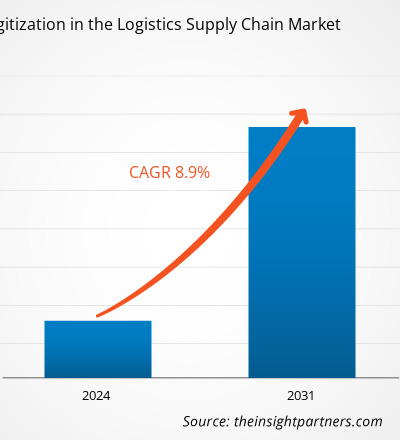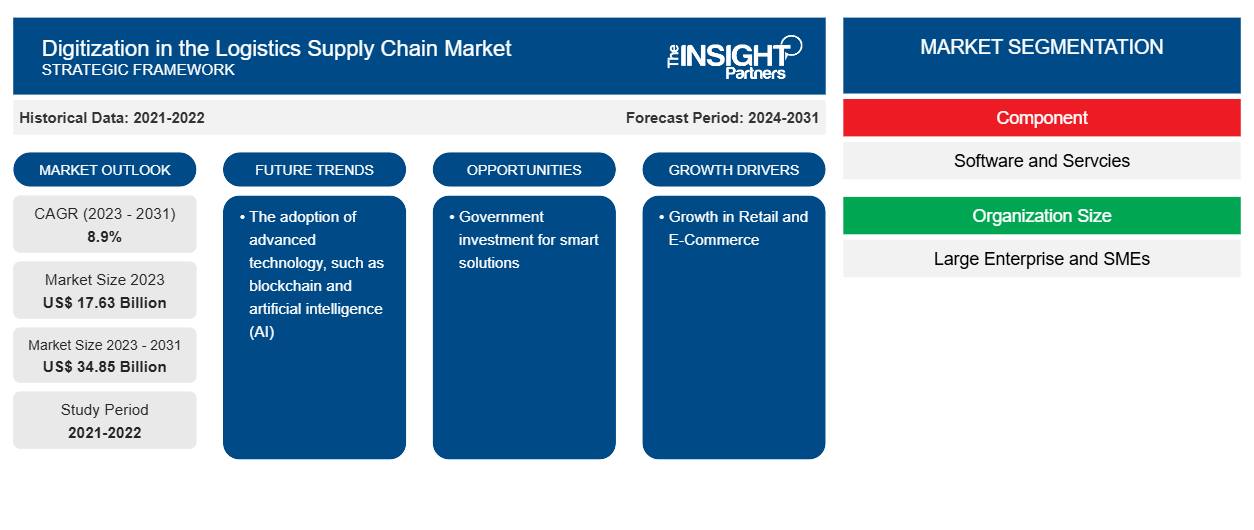物流供应链数字化市场规模预计将从 2023 年的 176.3 亿美元增至 2031 年的 348.5 亿美元。预计 2023-2031 年市场复合年增长率将达到 8.9%。供应链管理需求的不断增长以及零售和电子商务行业的不断增长可能仍是物流供应链市场数字化趋势的关键。
物流供应链数字化市场分析
汽车、零售和电子商务、制造业、医疗保健等各个行业的自动化通过减少人为错误,使这些行业的运营商受益匪浅。例如,全球零售业正在不断增长,预计未来还会进一步增长。因此,不断增长的零售业正致力于通过消除库存和管理供应链和物流的手动操作来降低总运营成本。整个零售业对自动化解决方案的需求推动了市场的发展。多个行业的物流部门正在经历数字化转型,因为利益相关者倾向于最大限度地减少错误、增强运营和准时交货,这推动了市场的发展。
物流供应链数字化市场概览
数字化转型的不断推进正在改变传统的商业模式,使其更加有效和高效。采用数字技术可以帮助多个行业的市场参与者通过优化其商业模式获得相对于其他参与者的竞争优势。数字化物流供应链运营有助于他们节省劳动力成本、加快流程并最大限度地减少错误。人工智能 (AI) 等更先进技术的加入有助于他们利用高级分析做出有效的业务决策。
定制此报告以满足您的需求
您可以免费定制任何报告,包括本报告的部分内容、国家级分析、Excel 数据包,以及为初创企业和大学提供优惠和折扣
-
获取此报告的关键市场趋势。这个免费样品将包括数据分析,从市场趋势到估计和预测。
物流供应链市场驱动因素和机遇中的数字化
零售和电子商务增长利好市场
个人收入和购买力的提高是导致零售和电子商务行业增长的主要因素。移动普及率和互联网连接的提高为零售业提供了可行性和易访问性,从而推动了电子商务行业的不断发展。根据印度品牌资产基金会 (IBEF) 的数据,美国、加拿大、德国、英国、中国、日本、法国、澳大利亚、瑞士、意大利和印度等国家都拥有强劲的零售市场。物流供应链中的数字化有助于供应链中的利益相关者优化其运营。数字化有助于实时跟踪和追踪供应链中的订单和原材料。它有助于制造商、供应商、分销商和零售商之间的有效协调,以降低成本、提高质量并满足客户需求。因此,零售和电子商务的增长推动了对解决方案的需求,以增强供应链和物流工作流程,从而进一步推动了物流供应链市场增长中的数字化。
政府对智能解决方案的投资——物流供应链市场数字化的机会
为了推动全球数字化,政府正在投资智能解决方案。引入智能解决方案有助于提高生产率、优化运营并提供更高的投资回报。它有助于简化复杂的业务模式并促进更快的运营。
- 2023 年 9 月,拜登-哈里斯政府宣布投资 1.6 亿美元用于智能交通技术。这项投资还侧重于系统创新,例如配送和物流、交通信号、智能电网和数据集成。
- 2023 年 2 月,印度财政部长宣布为印度专用货运走廊公司 (DFCC) 拨款约 33.635 亿美元(2748.2 亿印度卢比),比上一年增加 75%。预算演讲强调优先考虑 100 个关键交通基础设施项目,例如港口、煤炭、钢铁、化肥和粮食的最后一英里和第一英里的运输。
因此,此类投资可以促进物流和供应链领域的数字化,并成为市场增长的机会。
物流供应链市场报告细分分析中的数字化
在物流供应链市场分析中,促成数字化的关键部分是组成部分、组织规模和行业。
- 根据组件,市场分为软件和服务。2023 年,软件部门占据了更大的市场份额。
- 根据组织规模,市场分为大型企业和中小型企业。大型企业在 2023 年占据了最大的市场份额。
- 按行业划分,市场分为零售和电子商务、医疗保健、制造业、汽车等。零售和电子商务领域在 2023 年占据了最大的市场份额。
物流供应链数字化市场份额按地区分析
物流供应链市场报告中数字化的地理范围主要分为五个区域:北美、亚太、欧洲、中东和非洲、南美/南美和中美。
从收入来看,北美在物流供应链数字化市场中占据最大份额。美国、加拿大和墨西哥是北美的主要国家。该地区是技术先进解决方案的早期采用者,这是推动市场增长的关键因素之一。该地区零售和电子商务行业的兴起产生了对数字解决方案的需求,以优化供应链和物流活动,从而促进了市场的发展。根据美国商务部的数据,2024 年 2 月美国零售和食品服务销售额与 2024 年 1 月相比增长了 0.6%。此外,根据国际贸易管理局的数据,2022 年加拿大的电子商务用户约占加拿大总人口的 75%,预计到 2025 年将上升到 77.6%。加拿大网上购物的人越来越多,这有助于该国增加电子商务活动,例如产品配送业务。
物流供应链市场数字化区域洞察
Insight Partners 的分析师已详细解释了预测期内影响物流供应链市场数字化的区域趋势和因素。本节还讨论了北美、欧洲、亚太地区、中东和非洲以及南美和中美洲的物流供应链市场细分和地域的数字化。

- 获取物流供应链市场数字化的区域特定数据
物流供应链市场数字化报告范围
| 报告属性 | 细节 |
|---|---|
| 2023 年的市场规模 | 176.3亿美元 |
| 2031 年市场规模 | 348.5亿美元 |
| 全球复合年增长率(2023 - 2031) | 8.9% |
| 史料 | 2021-2022 |
| 预测期 | 2024-2031 |
| 涵盖的领域 |
按组件
|
| 覆盖地区和国家 |
北美
|
| 市场领导者和主要公司简介 |
|
物流供应链市场参与者密度的数字化:了解其对业务动态的影响
物流供应链市场数字化正在快速增长,这得益于终端用户需求的不断增长,而这些需求又源于消费者偏好的不断变化、技术进步以及对产品优势的认识不断提高等因素。随着需求的增加,企业正在扩大其产品范围,进行创新以满足消费者的需求,并利用新兴趋势,从而进一步推动市场增长。
市场参与者密度是指在特定市场或行业内运营的企业或公司的分布情况。它表明在给定市场空间中,相对于其规模或总市场价值,有多少竞争对手(市场参与者)存在。
在物流供应链数字化市场运营的主要公司有:
- 思爱普
- 甲骨文公司
- IBM
- 英特尔公司
- 信息技术
- 深圳市海克斯科技有限公司
免责声明:上面列出的公司没有按照任何特定顺序排列。

- 了解物流供应链市场数字化顶级关键参与者概况
物流供应链市场数字化新闻和最新发展
通过收集一手和二手研究后的定性和定量数据来评估物流供应链市场的数字化,其中包括重要的公司出版物、协会数据和数据库。以下是市场发展情况的列表:
- 2023 年 12 月,富士通宣布推出一项新的基于云的物流数据标准化和可视化服务,面向整个供应链中的托运人、物流公司和供应商。该服务为客户提供了新工具,以实现运营的可持续性并应对各种挑战,包括迫在眉睫的卡车司机短缺、迫切需要减少运输的碳足迹以及遵守更严格的行业法规。(来源:富士通,新闻稿,2023 年)
- 2024 年 1 月,领先的供应链解决方案提供商 Blue Yonder 宣布发布公司历史上最大的产品更新,推出了第一套可跨整个供应链(从规划到仓库、运输和商业)的互操作解决方案,这些解决方案均基于公司的 Luminate 认知平台交付。借助互操作性,Blue Yonder 可以为客户提供更高的生产力、更少的浪费和更具弹性的供应链。(来源:Blue Yonder,新闻稿,2024 年)
物流供应链市场数字化报告范围和交付成果
“物流供应链数字化市场规模和预测(2021-2031)”报告对以下领域进行了详细的市场分析:
- 范围内涵盖的所有主要细分市场的全球、区域和国家层面的市场规模和预测
- 市场动态,如驱动因素、限制因素和关键机遇
- 未来的主要趋势
- 详细的 PEST/波特五力分析和 SWOT 分析
- 全球和区域市场分析涵盖关键市场趋势、主要参与者、法规和最新市场发展
- 行业格局和竞争分析,涵盖市场集中度、热点图分析、知名参与者和最新发展
- 详细的公司简介
- 历史分析(2 年)、基准年、预测(7 年)及复合年增长率
- PEST和SWOT分析
- 市场规模、价值/数量 - 全球、区域、国家
- 行业和竞争格局
- Excel 数据集
近期报告
相关报告
客户评价
购买理由
- 明智的决策
- 了解市场动态
- 竞争分析
- 客户洞察
- 市场预测
- 风险规避
- 战略规划
- 投资论证
- 识别新兴市场
- 优化营销策略
- 提升运营效率
- 顺应监管趋势























 获取免费样品 - 物流供应链市场的数字化
获取免费样品 - 物流供应链市场的数字化